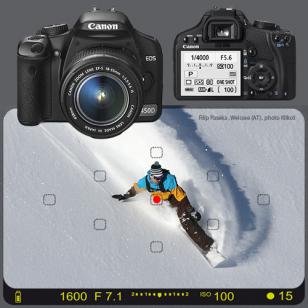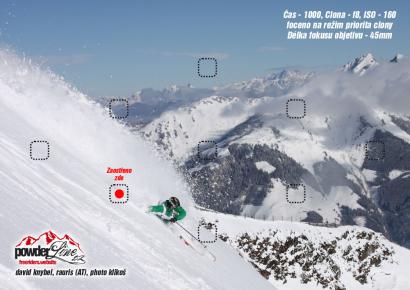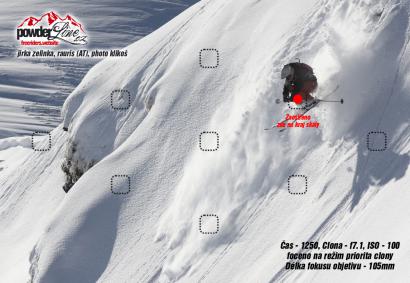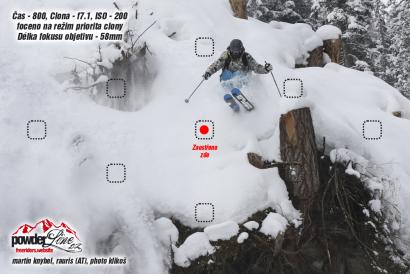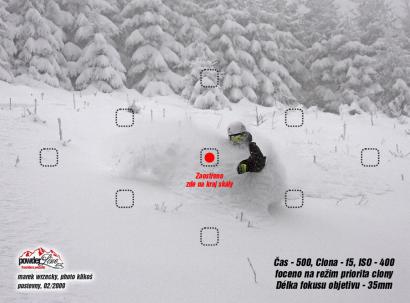Freeride photography with DSLR
or the first advices how to make the the best picture
Insert: 05.12.2009
In previous article, we got familiar with what kinds of cameras are actually suitable for freeride photography. In its essence it does not matter what kind of DSLR (Digital Single-Lens Reflex camera) you have. Whether it is for amaters or for professionals. The main thing is that it’s the DSLR.
Whole freeride photography is about image sharpness, which depends on several factors. Good composition is always composed of a good timing, depth of aperture, iso and perfect balance of focused lens. It's quite an alchemy to make a perfect freeride photo. Perhaps I can state with a calm heart that I dont know more extreme position than the white snow. Fast sport performance and often poor or lack of light of the whole composition.
Let’s start from the beginning. First of all you should know what lenses to use in your compositions. As a basic lens, I would recommend a glass of values around 20-80 with aperture somewhere around max f4. I guess I would not recommend you the sort of cheap plastic lenses. Although they are cheap, but not good at all the artwork and photos are a lot of "dull". This lens is most often use. Usually the situation will not allow use others glass.
Additional lenses, I would recommend a wide lens, such as 12-24 or fish eye, which has an interesting looking photo. And then also a telephoto lens 70-300 or 70-200. These additional lenses, of course, leave your consideration and your financial situation.
What actual lens is good for:
"Standard zoom" - for most photos. If you want to have a shreding rider with background behid him and do not want to go 2 meters from you and throw snow all over you, so just use this one. For this lens you can pay extra, because its worth it.
"Wide zoom" - this lens is usually for photos at hand. I personally take pictures so that I'll go to the rock as much as possible and then the rider is pretty high and you can see the whole backround.
"Telephoto" - telephoto lens is great for photographing big mountain line. You are down or at some opposite place and you snap a rider riding on the opposite wall. Its not trimmed photo, but the real ride.
This is all about the lenses and now I ll tell you what a good photographer must do to make a good photo happened:
It's really alchemy, so let's look at sample examples here:
SUNNY DAYS - in a beautiful sunny day is not big deal with adjusting your camera because there is enough of light, there is no need to exaggerate the ISO, is plenty of shade and all is nice sharply focused.
PARTLY CLOUDY - similar to the sunny days, but it is a problem when a cloud comes and lose perfect shadows and its a bit more dark. In this case you need to catch up all over the ISO, maybe a little lower the aperture somewhere around the number f 7.1.
CLOUDY (diffusion) - usually in this weather you can not photograph very well. You can only take pictures in the woods or in a places where is not completely white around you. The majority of the forest is usually not such a fog as it is when you are on the plain. Here you go with the times and the curtain down, but not in some meaningless numbers. Time to at least 400, the aperture 4 and ISO around 400 to 640. By reducing the aperture you get rid of the advantage over the poor focusing and thus you have to zoom in perfectly where the rider exactly is.
SNOWING – take a crap on shooting and go riding, it's reasonable. The photographer suffer and so do the thetechnology...
ON the next epiozode of freeride photographying, we will discuss taking picture in “Azuro days”.
Klikos
Let’s start from the beginning. First of all you should know what lenses to use in your compositions. As a basic lens, I would recommend a glass of values around 20-80 with aperture somewhere around max f4. I guess I would not recommend you the sort of cheap plastic lenses. Although they are cheap, but not good at all the artwork and photos are a lot of "dull". This lens is most often use. Usually the situation will not allow use others glass.
Additional lenses, I would recommend a wide lens, such as 12-24 or fish eye, which has an interesting looking photo. And then also a telephoto lens 70-300 or 70-200. These additional lenses, of course, leave your consideration and your financial situation.
What actual lens is good for:
"Standard zoom" - for most photos. If you want to have a shreding rider with background behid him and do not want to go 2 meters from you and throw snow all over you, so just use this one. For this lens you can pay extra, because its worth it.
"Wide zoom" - this lens is usually for photos at hand. I personally take pictures so that I'll go to the rock as much as possible and then the rider is pretty high and you can see the whole backround.
"Telephoto" - telephoto lens is great for photographing big mountain line. You are down or at some opposite place and you snap a rider riding on the opposite wall. Its not trimmed photo, but the real ride.
This is all about the lenses and now I ll tell you what a good photographer must do to make a good photo happened:
- Never shoot with fully automatic mode
- Have only 1 focused point - if you have more then one focused point the rider will not be fucused and could be fuzzy
- You have to watch the timing - this is very important - the freeride is usually shoot at least starting 640/1000, I personally take pictures most of the times 1200/1000 and higher. If you use a telephoto lens without the stabilizer the times are around 2000/1000 and if with stabilizer around the 1200/1000.
- Aperture (f) to have somewhere around number 7.1 to 10 because if you focuse somewhere else than the rider goes the aperture usually saves it.
- Iso must be adjusted according mentioned parametres above.
It's really alchemy, so let's look at sample examples here:
SUNNY DAYS - in a beautiful sunny day is not big deal with adjusting your camera because there is enough of light, there is no need to exaggerate the ISO, is plenty of shade and all is nice sharply focused.
PARTLY CLOUDY - similar to the sunny days, but it is a problem when a cloud comes and lose perfect shadows and its a bit more dark. In this case you need to catch up all over the ISO, maybe a little lower the aperture somewhere around the number f 7.1.
CLOUDY (diffusion) - usually in this weather you can not photograph very well. You can only take pictures in the woods or in a places where is not completely white around you. The majority of the forest is usually not such a fog as it is when you are on the plain. Here you go with the times and the curtain down, but not in some meaningless numbers. Time to at least 400, the aperture 4 and ISO around 400 to 640. By reducing the aperture you get rid of the advantage over the poor focusing and thus you have to zoom in perfectly where the rider exactly is.
SNOWING – take a crap on shooting and go riding, it's reasonable. The photographer suffer and so do the thetechnology...
ON the next epiozode of freeride photographying, we will discuss taking picture in “Azuro days”.
Klikos



